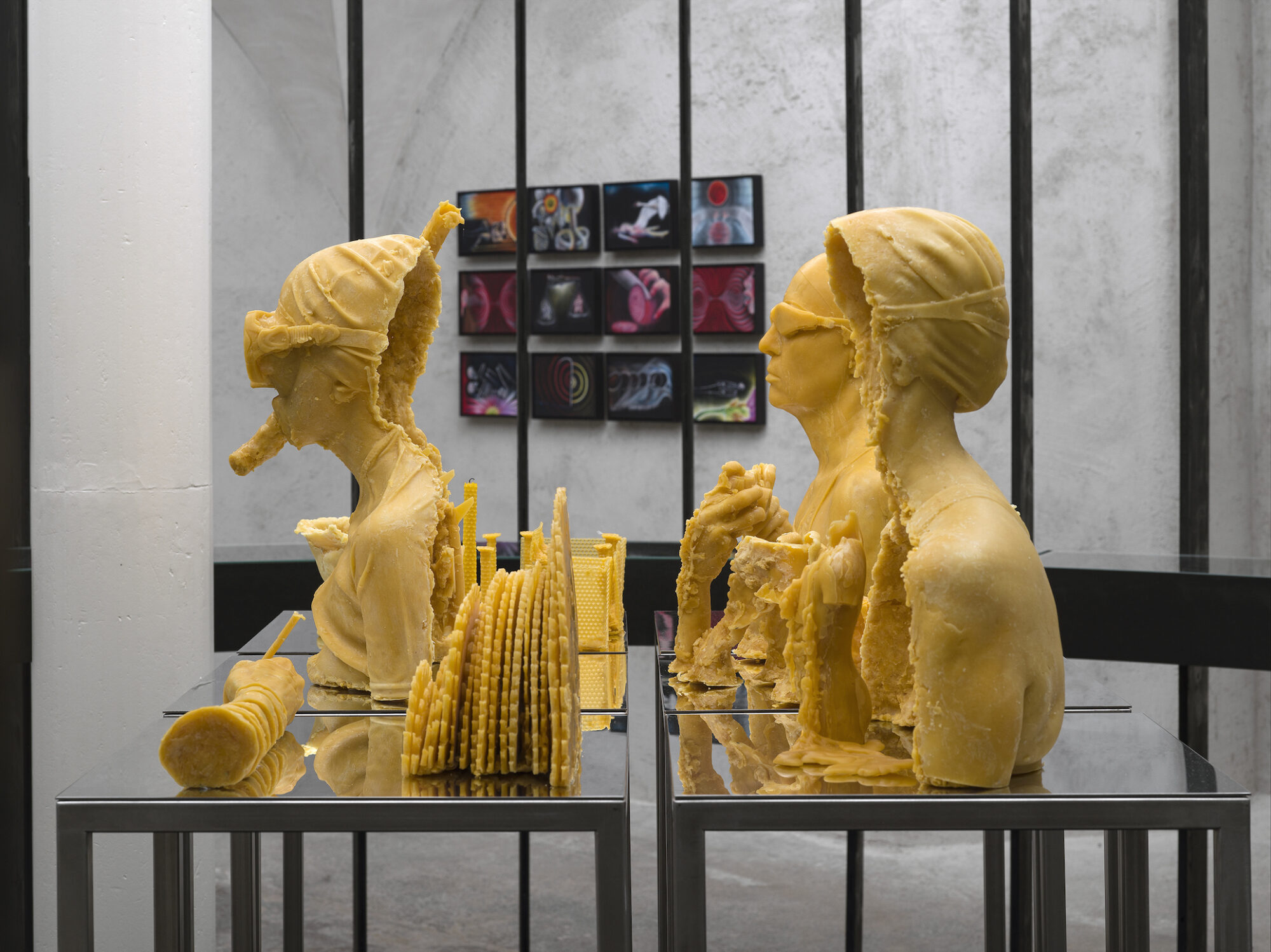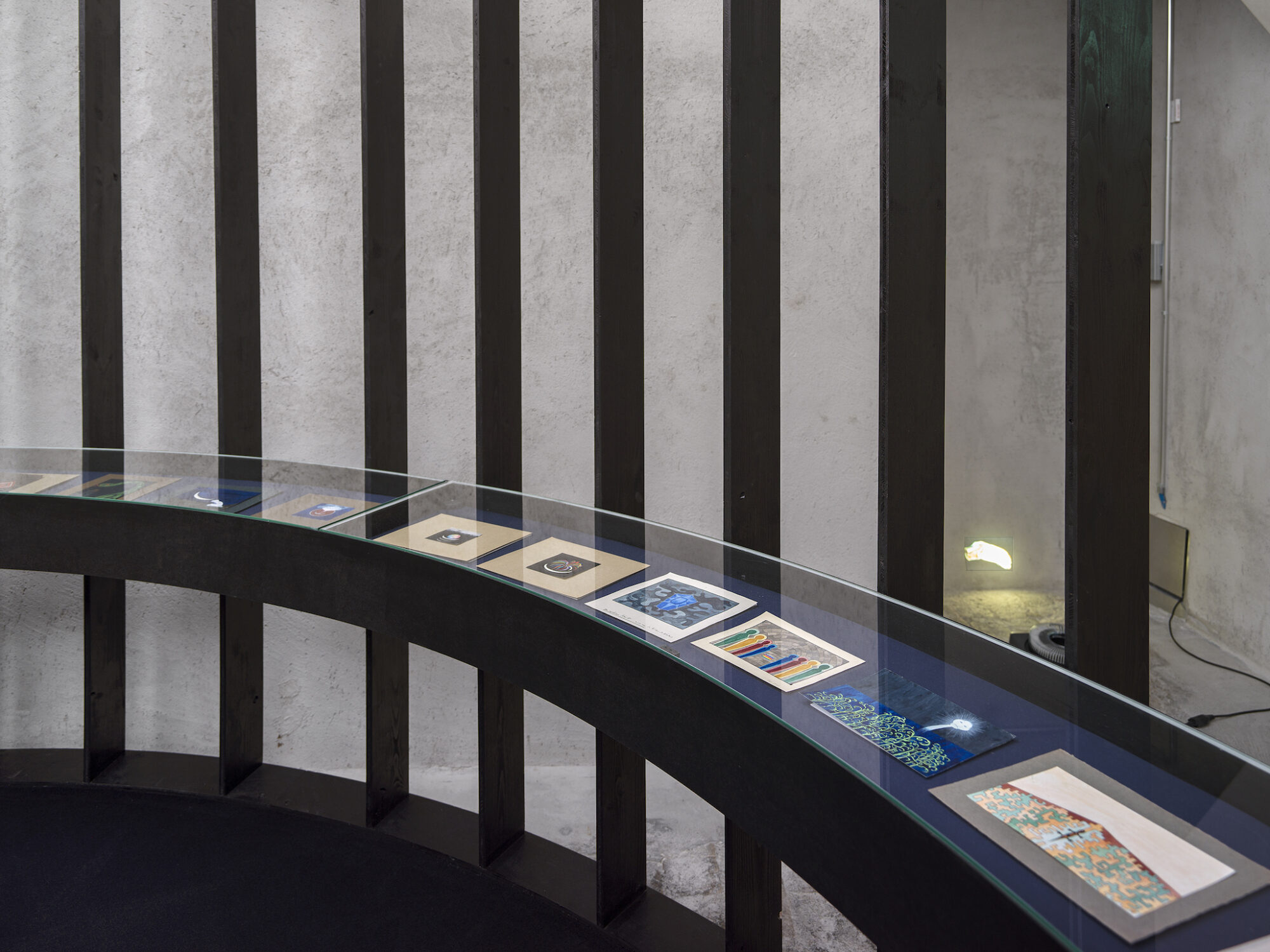You can find the complete exhibition text here.
When the Cabaret Voltaire opened as «Künstlerkneipe Voltaire» on February 5, 1916, its initial program – advertised on a poster designed by Marcel Słodki – first announced «music recitals and recitations.» Music was indeed central to the Dada impulses that unfolded during the Soirées, first at Cabaret Voltaire, then at the movement’s various venues in Zurich, and later transcending both national and European borders. Yet, neither in Dada Zurich’s historiography nor in the common conceptions of the movement, music is as prominently featured or contextualized in its full complexity. The «Interlude» program in the Vaulted Cellar unfolds in two acts from February to April 2025 and thematizes Dada’s legacy in relation to music and sound, while also creating space for contemporary practices and discourses. The title «Interlude» refers to the traditional structure of musical compositions and to what hap- pens during the interval between parts of a larger composition. At Cabaret Voltaire, «Interlude» activates the Vaulted Cellar between the usual exhibition program, inviting the audience to a different kind of immersive and reflective experience.
Dada is often associated with loud disturbing sounds as well as chaos and randomness. Yet, the program sheets and chronicles of various protagonists reveal that the Dada Soirées in Zurich brought together many opposing artistic directions of the time: experiments with noise shared the stage with pieces rooted in the Western harmonic musical tradition, played by protagonists such as Hans Heusser and Suzanne Perrottet. At Cabaret Voltaire and the later Zurich venues, one could hear romantic pieces by Saint-Saëns and Rachmaninov, as well as folk music in German, French, Danish and Russian, brought by the movement’s inter- national protagonists, most of whom were fleeing the First World War. The two founders of Cabaret Voltaire were professionally active as cabaret musicians. During the Dada Soirées, Emmy Hennings sang folk songs and Hugo Ball played ragtime music on the piano. However, against a backdrop of disillusionment stemming from the crises of the war, Dada also developed new artistic languages that often drew on anti- traditional principles and used rhythm and sound as artistic materials.
Some of these innovations were shaped by the appropriation of non-European idioms; what was problematically labeled as «primitive» was embraced as a liberating alternative to communicate more directly with the public and disrupt the established norms of traditional Western art and the values of bourgeois society. With access to examples of African poetry, Zurich’s Dada artists incorporated «Chants N_» and the bruitist works of Richard Huelsenbeck into their Soirées programs, without critically reflecting on this appropriation. On the other hand, a crucial part of the experimental sound research of Dada artists also unfolded in questioning language as a tool of propaganda, in a context where nationalism established itself exponentially, which resonates with today’s political reality.
One of Dada’s artistic strategies was to understand words no longer as signifiers but as sound and use them as rhythms and intonations. A few years before the opening of Cabaret Voltaire, the futurist Luigi Russolo published the manifesto L’Arte dei Rumori (The Art of Noises), in opposition to academism and tradition, while seeking a direct and dynamic impact on the audience. Yet, within Futurism, the reproduction and declamation of machine and war sounds is to be understood as a proto-fascist celebration of modernity. In contrast, Dada artists used language itself to question nationalist propaganda, critiquing the violence of the modern age and war. This is particularly evident in the development of the new forms of sound poetry and simultaneous poetry, used mainly by Hugo Ball and Tristan Tzara, in which the noise of nonsensical words stands for an opposition to normative rationality. In these sonic tactics, the body was the instrument and place of declamation, and thus, a form of opposition against structures of power and rules.
The development of experimental music in the 20th and 21st centuries owes a certain legacy to Dada. The movement’s anti-bourgeois ethos resonates with various movements, such as Fluxus, or the punk and noise music genres, all of which embrace sound as a site of opposition. Figures such as Merzbow – the stage name of the pioneering Japanese noise artist of the 1980s and 1990s Masami Akita – or the industrial band Cabaret Voltaire demonstrate these historical links, with Akita directly referencing Dada artist Kurt Schwitters’ Merzbau. The processes of aleatoric creation exemplified by Tzara’s «cut-up» technique, or collage and assemblage, find a particular echo in sampling cultures, in the pioneering experimental compositions of John Cage, or in musique concrète and its sound collages. The use of urban soundscapes, field recordings and various environmental sounds in today’s electronic music resonates with Ball’s sound poetry. The centrality of the body and performance in this form of poetry is also crucial to contemporary sound art practices that blur the lines between music, poetry and the visual arts. The rejection of norms and the search for raw sounds in the various directions of noise music align with the transgressive ethos of Dada.
«Interlude» bridges the gap between this history and contemporary sound practices, giving them space as an echo to Dada’s legacy.
The first act of «Interlude» presents WURM, an experimental space for everything that sounds adventurous, exploratory, noisy, improvised, speculative, and charmingly weird. Founded 2011 in Basel, it evolved into a buzzy hub for workshops, performances and collaborative projects. For «Interlude» WURM occupies the Cabaret Voltaire for a month, presenting experimental and new sounds.
The Vaulted Cellar is transformed into a stage, activated by performative actions and new sounds. The program includes various sound performances, taking place during two Soirées on February 7 and March 1, 2025. In between these events, the space is inhabited with recordings of the performances. In the center of the room hangs a unique lamp, usually present in the original WURM space, now displaced as part of the scenography to invite new happenings. The focus shifts from the visual to the auditory, as an invitation to experience the space differently.
The program of «Interlude, Act 1: WURM» is organized in collaboration with Mercury Tracer, an event series based in Basel and launched at WURM that serves as a platform for ultra-contemporary artists from the fields of ambient, experimental music and experimental club music. Curated by Flavia Senn and Mattia Comuzzi, Mercury Tracer showcases the diversity and innova- tion of a new generation of musicians and puts local and international, forward-thinking voices at the center to break traditional boundaries and give room to innovative forms of expression. For the Soirée of February 7, 2025, Elie and Gaspard Emma Hers have been invited to perform their works in the Vaulted Cellar. Find out more here. For the Soirée of March 1, 2025, Violeta García has been invited. Find out more here. The recordings of these performances create the soundscape for the first act of «Interlude».
Elie is a DJ and sound artist based in Neuchâtel, Switzerland. In performances close to harsh noise, she explores the sonorities of unexpected materials, such as syringe garbage cans, and aggressive sounds created by DIY granulators as well as EDM samples. In her practice, the body is at the center, exploring its lim- its and its breath, as a creative and subversive energy. Here, noise simultaneously amplifies bodily movements and saturated sounds to an extreme, presented without any pretense of savoir-faire. As she moves through space, she also plays with the resonance of sound through feedback, creating a triptych between body, machine and space. The artist appropriates the violence of sound to convey it in her own terms, creating a kind of dystopian sonic high that amplifies the over-stimulation of the brain as a commentary on con- temporary violent realities for bodies and the power structures they must conform to. Confronted with dark tones and disrupted frequencies, the audience’s hear- ing and orientation are challenged as part of a cathartic procession.
Gaspard Emma Hers – also known as DJ Würm – is a multidisciplinary artist from Brussels, Belgium. Their music delves in liminal spaces between fiction and personal archive; they propose a journey into a landscape that echoes the sound of distant raves and develops into an introspective ambient noise piece. There is no narrative line to follow, but some images can be grasped in order to find a pathway into endless echoes, loops and vibrations. The artist assembles different sonorities like a floating collage, fragmented by deep bass and strident sounds. It is an invitation to call upon one’s own mythology, references and soundscapes, to let personal emotions create connections with the multiple and diverse layers of sound. The fantasy world that unfolds inhabits the medieval architecture of the Vaulted Cellar, whispering legends into the audience’s ears and blurring the temporalities of the past and future. Music is present as a distinct material with a liberating bodily effect, inviting sensitive dance and emotional release.
The cellist, composer, and curator Violeta García moves across many art forms such as free improvisation, electronic music, and contemporary experimental music for violoncello. Originally from Buenos Aires and currently living in Bern, the artist showcases the cello’s versatility while challenging traditional notions of recording and performance. At Cabaret Voltaire, she presents new sounds that push the boundaries of musical convention. Her work trans- forms the site-specific acoustics of the Vaulted Cellar with minimalistic contemporary music, dark ambient and experimental noise. Through resonance and reverberation, the sound has a haunting, immersive quality, and interacts organically with its environment. Drawing inspiration from composers like La Monte Young, Eliane Radigue, Jürg Frey, and Arvo Pärt, García integrates elements of sacral minimalism and acoustic experimentation in a performance that bridges improvisation and composition. The harmonies of the cello are twisted and stretched to a point of decomposition and recomposition, as a commentary on the experimental and liberating potential that can also be found in classical instruments.
For the second act of «Interlude», from March 11 until April 27, the BaseCamp Library inhabits the space. Find out more here.











